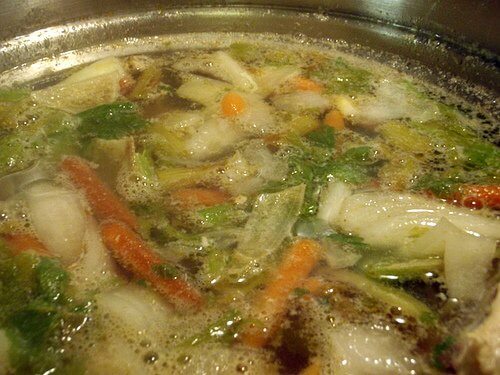Homemade Soup Broth: An Essential Element in Any Healthy, Frugal Kitchen

Image by joyosity
Ever wonder why fokelore has always included chicken soup as a remedy for the common cold? And why your Grandma’s tastes just so good (so much better than any canned or dry variety ever could)?
The secret is in the broth. Rich, delicious, nourishing homemade soup stock.
Why is chicken soup superior to all the things we have, even more relaxing than “Tylenol?” It is because chicken soup has a natural ingredient which feeds, repairs, and calms the mucous lining in the small intestine. This inner lining is the beginning or ending of the nervous system. It is easily pullled away from the intestine through too many laxatives, too many food additives… and parasites. Chicken soup… heals the nerves, improves digestion, reduces allergies, relaxes and gives strength. Hanna Kroeger- Ageless remedies from mother’s kitchend
Properly prepared, meat stocks are extremely nutritious, containing the minerals of bone, cartilage, marrow and vegetables as electrolytes, a form that is easy to assimilate. Acidic wine or vinegar added during cooking helps to draw minerals, particularly calcium, magnesium and potassium, into the broth. Dr. Francis Pottenger, author of the famous cat studies as well as articles on the benefits of gelatin in broth, taught that the stockpot was the most important piece of equipment to have in one’s kitchen.
Sally Fallon– Nourishing Traditions
And to add to all the health benefits, for all of us frugally minded mamas…
The public is generally unaware of the large amount of research on the beneficial effects of gelatin taken with food. Gelatin acts first and foremost as an aid to digestion and has been used successfully in the treatment of many intestinal disorders, including hyperacidity, colitis and Crohn’s disease. Although gelatin is by no means a complete protein, containing only the amino acids arginine and glycine in large amounts, it acts as a protein sparer, allowing the body to more fully utilize the complete proteins that are taken in. Thus, gelatin-rich broths are a must for those who cannot afford large amounts of meat in their diets. Cont’d from Nourishing Traditions
In a nutshell, homemade stock made of chicken, cow or fish bones, is an incredible source of minerals, electrolytes, and especially gelatin, all of which boost our health through important nutrients or improve our digestion (which goes completely hand in hand with our health and absorption of nutrients).
And (can it get much better?) if your budget cannot allow for large quantities of good quality animal protein, using broth in your soups, stews, rice, pasta sauces, etc. will enable your body to more adequately make use of the protein that you are able to eat!
So how do you make this most nourishing of foods?
Homemade Soup Broth
Ingredients
- Bones of one chicken preferably organic or free range (or at the very least hormone and antibiotic free) OR bag of beef bones (I buy mine for $5 a bag from my meat supplier, and this allows me to make a very large pot of stock)
- Apple cider vinegar
- Cold water
- 1 large onion
- 2-3 carrots chopped in large pieces
- 2-3 celery sticks chopped in large pieces
- Fresh parsley
- Salt
Instructions
- Begin with the chicken or beef bones. If you do not buy whole chickens, you can save the bones from your wings and legs in a bag in the freezer, until you have a sufficient amount (about equal to the size of a chicken carcass).
- Put the bones in a large stock pot, completely covered by cold water, add a few couple tablespoons of apple cider vinegar. Let this sit for about an hour.
- Bring to a boil, and remove the scum that rises to the top.Then add onion (chopped in quarters, leave the peel on for a beautiful yellow color in your stock), carrots and celery sticks. I like to save the remnants of these veggies whenever I'm chopping and preparing other dishes, and put them all in a plastic bag in the freezer until I'm ready to make broth. I just dump all these remnant pieces into my broth and it works just fine, and saves money for sure!
- Reduce heat, cover and simmer for 6 to 24 hours (the longer, the better, as this will allow the gelatin to be more fully released from the bones, and results in a more flavorful broth). You can add fresh parsley or thyme to your stock in the last 10-15 minutes. Also, add a bit of salt, to bring out the flavors.
- Pour through a strainer and set broth aside to cool (in the fridge is best, if you have enough room). Set aside bones and remove all meat for future soups, casseroles, etc. When broth is cool, remove layer of congealed fat from the top and discard.
- Put broth in containers (glass is ideal- old pickle or mayonnaise jars, or even canning jars, but plastic yogurt containers work well in a pinch). I like to put mine in several different size containers, so that I can remove the size I need depending on what I am doing (2 cups to add to rice, 2 quarts for making soup, etc.). Many people also freeze broth in ice cube trays, then once frozen, store in a large ziploc to take out small amount at a time.
(Recipe loosely taken from Nourishing Traditions, and partly just from my head)
You may find that the stock does not have that extra strong, store-bought bouillon type of flavor. This is because it is lacking in MSG (yes, even if the ingredients don’t list MSG, it is probably in there in a hidden form or under one of its many other names that manufacturers use to hide its presence).
Adding a bit of extra salt and seasonings to your soups will help to make up for this, although over time you will become accustomed to the more mild (yet richer at the same time) taste of homemade broth and will begin to prefer it, as we have.






Yum! I love homemade stock for soups. I’ll have to look into getting beef bones. I’ve never tried to make beef stock before. Thanks for the idea!
Fantastic post…when’s the soup ready? i’m coming over…i’ll bring the baquette. 🙂
blessings to the wonderful soup maker!
Vanessa, you’re welcome!
Lylah, you’d be welcome anyday!
My meat supplier won’t sell me bones because he says they haven’t been inspected or they are not approved to do so…but they do sell “dog bones”. I was wondering if you knew of any reason to avoid using them, or if I could boil the “dog bones” for our homemade soups! Or if you have any other sources for buying bones…(Bellingham, WA)
Lisa, that is a great question- to which I don’t have an answer! Let me put it out to the other readers!
Your terminology is a bit off. You are using stock and broth interchangeably, but they are two different things.
@joel, You’re right. Stock is from bones, broth includes meat.
.-= AmandaonMaui´s last blog ..Happy Father’s Day! =-.
This may be a dumb question, but what do you do with the cooked onions and carrots when you are finished?
@AP, People generally throw them away. Some have tried to save them for soups and stuff, but they’re really not that good. All of the texture and flavor have gone into the broth. You’ll get more flavor by adding fresh vegetables to your soup/meal.
.-= AmandaonMaui´s last blog ..Happy Father’s Day! =-.
AP, I just throw them out. Once they’ve been cooked to death like that, they’re nutrients and flavor are pretty much all in the broth, so they’re not really worth eating. That’s why I like to save up all my carrots, onion, celery, etc. scraps for the purpose of making broth, rather than using fresh veggies that we would have eaten.
Oh,really nice post,so great,thx
Thanks for the info on broths. I make my own, but always wondered if I was getting all the nutrients or not.
One question- can you get all the same benefits if you make it in a crockpot? For such long simmering it would be more economical.
This makes my mouth water! I could still remember my grandma cooking it for me.. But i was also wondering if the nutrients will be affected coz its a really long process of boiling. I love the kitchen and I love to cook nutritious and healthy foods!
Hi just found your site and loving it! So much more to explore. I have a question about cooking method on the stock, Is a crockpot ok? I am nervous leaving my gas stove top going for 24 hours. thanks again for the wonderful info!
@Emikat, Yes, you can definitely use a crockpot! I do that often, especially for chicken broth (beef is a bit harder because the bones are larger, but if you have a large crockpot you can probably still make it work).
I just found your blog today….I am loving it so far! I recently made homemade chicken stock with leftover scrapes and put it in a few glass jars (spaghetti sauce jars) and put them in the freezer. The other day I noticed one of the jars broke into a bunch of tiny pieces. Do you think I did something wrong? Do you just keep your jars of stock in the fridge?
I just wanted to mention that in culinary school we were taught to never boil a stock. This can make your stock cloudy. A bare bubble is what you’re looking for. Skim every 5 minutes for the first 30 minutes, and then skin every 30 minutes after that until your stock is to your liking.
I put my broth in glass jars and it cracked…how do you do it?
@Lisa,
I store everything in my freezer in glass jars (no plastic in my kitchen – I use canning jars) and my tip for no breaks or cracks is to make sure the product is cold before you put it into jars. Hot food + room temp jars = breakage. Also, leave an inch of space at the top to allow the food to expand when it freezes, otherwise it will shatter. It’s best to thaw frozen glass jars in the fridge overnight; if you thaw them on the counter put them on a rack or a towel. You want there to be something between the frozen jar and the countertop, otherwise it will crack. Avoid any sudden changes in temps; with glass jars when hot and cold meet you get a broken jar.
Great post, wondering what the cider vinegar does?
I am also going to ask my butcher about the ‘dog bones’
They sell those here too but not the other bones.
@Elizabeth, The vinegar helps to pull the gelatin and other nutrients (minerals like calcium) from the bones. You can make it without vinegar, but you likely won’t get the same nutrient content. I’ve never found that it makes my broth taste vinegary.
Great post! Only thing….skimming the fat from the top and tossing is a huge waste of nutrients. The grease may not be classy for modern restaurants, but is where all of the nutrients are you have just boiled by making your stock. Tossing it defeats the purpose. Those animal fats are highly nutritious and easy to digest. Check your Nourishing Traditions book for more info on that!
@Nichole, I’ve since learned that. This is an older post, and in the past two years I’ve begun to save all of my fat and consider it a very precious part of broth making. We love using it for all sorts of cooking!
@Stephanie @ Keeper of the Home, @Stephanie @ Keeper of the Home,
Stephanie,
I’m kind of new to the “from scratch” lifestyle, at least compared to many of the readers on here i’m sure. Anyway… this fat…. you say you save it? I instinctively knew it was valuable so I didn’t throw it out… but i also feel strange drinking broth that is especially oily (which it is if the fat is not removed). I do assume you are referring to the white stuff that cakes up at the top of the broth once it cools no? When you say you save it, do you mean you save it separately or in the broth? If separately, in what sort of storage medium and what kind of cooking do u use it for? Thanks so much!
@FOXP2, Yes, you can definitely save it. I like to freeze mine. You can see how I do it here: https://keeperofthehome.org/2010/04/homemade-beef-tallow-a-simple-and-convenient-way-to-store-it.html
I use mine for things like eggs, for roasting veggies, to fry onions for making soups or stews, etc. It’s a very versatile fat for savory dishes (I don’t personally use it for any baking, I think that might taste weird).
That looks very good
its great also I cook with it, and eggs are the best………
I’m going to make my first homemade stock tomorrow, thank you for the thorough instructions!
Hi
In your excellent post you write the following; “gelatin is by no means a complete protein, containing only the amino acids arginine and glycine in large amounts, it acts as a protein sparer, allowing the body to more fully utilize the complete proteins that are taken in.”
Which is correct, but it is not arginin, but hydroxyprolin/prolin and glycin that is found in large amounts. Percentages vary with the raw material (bones and cartilage or skin) and how it is cooked or manufactured, but typical amounts of glycin is 25,000 mg/100 gram, prolin is 14,000 mg/100 gram whereas arginin is only about 8,400 mg/100 gram.
Some references –
http://www.gmap-gelatin.com/about_gelatin_comp.html
http://augmentinforce.50webs.com/Gelatin.htm
Have fun 🙂
I forgot to add these links yesterday. It is info about the health benefits of broth and gelatin/glycin, for you or any of your blog visitors. Sorry about double posting –
http://www.townsendletter.com/FebMarch2005/broth0205.htm
http://www.westonaprice.org/food-features/515-broth-is-beautiful.html
http://www.westonaprice.org/food-features/513-why-broth-is-beautiful.html
http://raypeat.com/articles/articles/gelatin.shtml
http://findarticles.com/p/articles/mi_7396/is_328/ai_n56264937/
http://augmentinforce.50webs.com/Gelatin.htm
http://pathways4health.org/2010/02/05/february-2010-investing-in-stocks/
http://www.celluliteinvestigation.com/2010/09/glucosaminoglycans.html
Have fun 🙂
my husband and I have been buying local grown organic food. we have noticed a big differencein our energy levels. 🙂
Thanks for your marvelous posting! I truly enjoyed reading it, you can be a great author.I will make sure to bookmark your blog and definitely will come back later in life. I want to encourage you continue your great writing, have a nice weekend!
I have been making my own chicken broth for a few years and I always freeze it. I purhcased a whole grass fed beef and requested the bones for broth…wow, I have a lot. Is it not a good idea to can beef broth???
Somebody necessarily help to make significantly posts I’d state. That is the first time I frequented your web page and up to now? I surprised with the research you made to make this actual put up incredible. Fantastic job!
Thank you for any other informative site. Where else could I get that kind of information written in such an ideal way? I’ve a mission that I’m simply now working on, and I’ve been on the glance out for such info.
It’s in reality a great and helpful piece of info. I am happy that you shared this useful information with us. Please stay us up to date like this. Thanks for sharing.
Its such as you learn my thoughts! You appear to know so much approximately this, like you wrote the book in it or something. I think that you simply could do with a few p.c. to drive the message home a little bit, however instead of that, this is great blog. An excellent read. I’ll certainly be back.
Hi
I have a question about broths. I have been making broths the last few weeks and wondering why I do not see them gel. I hope that I am still getting all the benefits of them. When I made the beef broth I used the bones of grass fed beef from the freezer of my Whole Foods store. When I made the chicken I used the bones and carcass of a chicken I had cooked the night before. Is this ok or should I use the whole chicken to make my stock?
I only use the bones, not the whole chicken. For both types of broth, I always do a cold soak first, with some added apple cider vinegar (just a couple Tbsp). This seems to make a difference. Also, for chicken broth, adding in a couple chicken feet (I know, it’s a bit gross seeming, but it really helps) will improve the gelatin content a lot. I always get great gel in my beef broth just with the soaking and then boiling, but with chicken I get much better gel when I add in the feet.
but is it ok to use the bones and carcass of a chicken that you baked the night before, or do they have to be rew, uncooked before.??
I discovered your site today and I’m finding it very helpful and informative! I’ve only made bone stock once, it didn’t gel. I soaked backs and wings with 2T. ACV for an hour, simmered very low for 24hrs. My question is, when adding feet do you need to skin them before making your stock? I read on another site if you leave it on it gives the stock and odd taste. Also I plan on using about 2 gallons of water, how much feet and ACV should I add?
I just made a big batch of stock with just soup bones and a whole lot of vegetable peelings and bits that would otherwise go in the compost. Once I strained the broth/stock, I usually feed the rest to the dog. However there was far to much to feed the dog at his next mealtime. I thought I freeze it in ice cube trays, but my freezer is way to full. So the next thing to to was to put it through the blender and stick it in the dehydrator. Wow what a fabulous end product. Good enough to eat as vegie chips. They were so yum! I put the the rest of the dired sheets of vegetable pure through the blender to pulverize. That would make a good instant soup. Just add hot water. To expand on this I just blended a cup of beef, barley and veg soup and its going in the dehydrator now.
Don’t skim the top that is where the nutrients are if your looking for the health benifits.
I always make stock with my turkey carcasses at Thanksgiving and Christmas. After dinner I throw the carcas, vegetables and water in the crockpot and let it cook all night. Then I store it in glass jars and freeze.
Hi- just wondering if I should be re-filling the broth as it broths away on my stovetop to keep the bones covered?
Cheers- Sonia
Thank you for all this. I just saved the recipe for homemade soup broth and am anxious to try it. I appreciate you taking the time to post these things
Hi, could you clarify something for me, recipes in other sites (not GAPs related) says we have to roast the bones (beef) first. Do you do this ?
Thanks,
Cathy
The broth/stock can be frozen in glass jars with metal lid? How do you defrost your broths?
Thank you for your blog information! I’m making a pot right now as my entire family is sick with something. So happy to have it all laid out like this especially when I’m hardly well enough to get the information in my head 🙂
I am fairly new to your site. and I am loving it! I have a question… I just started my broth. I am wondering if when I am done can I reuse the bones and make more broth from it? I read somewhere else that I could reuse the bones for a second or third time. I wondered if the nutrients would be stripped from the bones after the first 24 hours. Thanks!